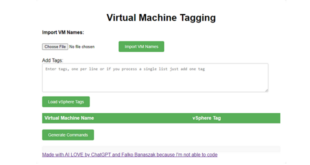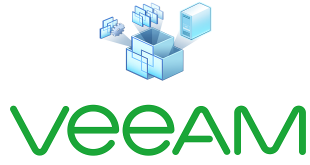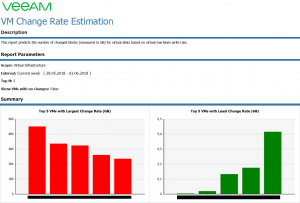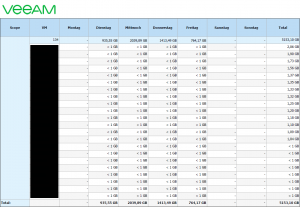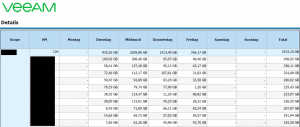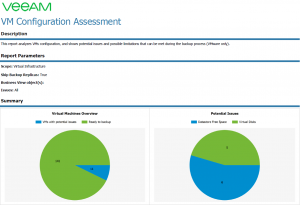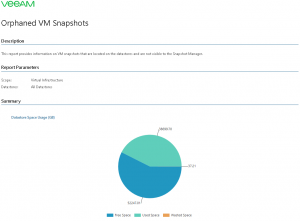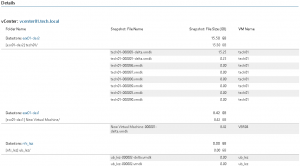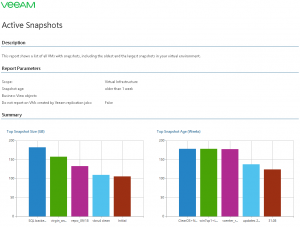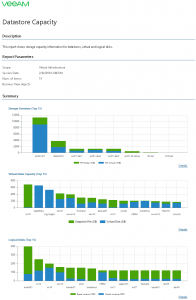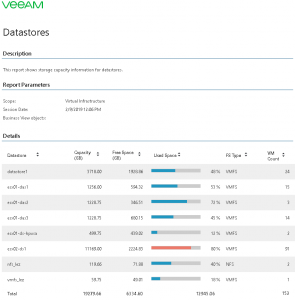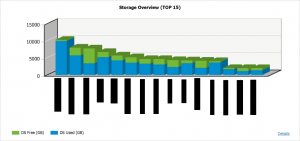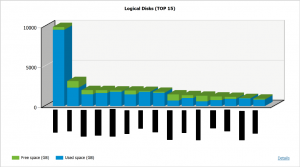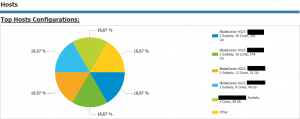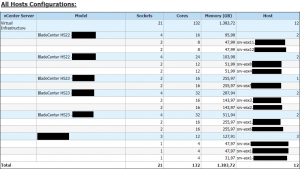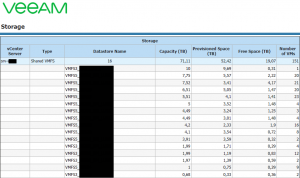Introduction
With this blog post I would like to introduce my top 5 Veeam ONE Reports for VMware, which I use in various projects regarding VMware and backup infrastructure planning.
Veeam ONE is designed for documenting and reporting on the Veeam Backup & Replication infrastructure, VMware vSphere, vCloud Director and Microsoft Hyper-V environments.
For doing so, there are several reports available by default to document and report your environment.
Predefined Veeam ONE Reports
Veeam ONE has a lot of predefined reports, which can be directly executed out of the Veeam ONE Reporter. A list of all predefined Veeam ONE Reports can be found on the Veeam Help Center.
Out of all these predefined reports, I therefore picked my personal top 5 Veeam ONE Reports for VMware. I often use these regarding infrastructure assessments or preparation on implementing or changing a VMware or Veeam Backup & Replication infrastructure.
My Top 5 List
- VM Change Rate Estimation Report
- VM Configuration Assessment Report
- Orphaned VM Snapshots Report & Active Snapshots Report
- Datastore Capacity Report
- Infrastructure Overview Report
VM Change Rate Estimation Report
The VM Change Rate Estimation Report is definetely the one I have used the most so far. This report predicts the number of changed blocks (in GB) for virtual disks based on virtual machines write rate. It is definetely one of the best reports when it comes to define a nearly exact change rate prior sizing a Veeam Backup & Replication environment.
In most cases I use Veeam ONE to monitor the environment for at least a month. With the data generated out of this whole month and the VM Change Rate Estimation Report i can define a pretty good change rate which I use for the backup storage sizing of the environment.
The summary section of this report shows the top 5 VMs with the largest change rate and the top 5 VMs with the least change rate.
While looking into the details of the report, you are able to see different change rates depending on the set reporting interval.
Here are some examples out of a generated report from myself.
Link to the VM Change Rate Estimation Report in the Help Center
VM Configuration Assessment Report
Another report which I use at almost every new Veeam Backup & Replication customer. The VM Configuration Assessment gives me insights about the “readiness” of virtual machines to backup with Veeam. This report analyzes the configuration of the VMs and shows potential issues or limitations when performing backup with Veeam Backup & Replication.
The summary section of this report shows the overview of the virtual machines and their potential issues within their configuration. It also shows all VMs that are “ready to backup”. All in all this report is a gamechanger when it is needed to quickly get the potential “showstoppers” before implementing a new Veeam Backup & Replication infrastrucuture !
In the following screenshots are some examples of a VM Configuration Assessment Report. You are able to see some virtual machines with physical raw device mappings. VMs with physical RDMs and independent disks cannot be backed up with Veeam Backup & Replication. Therefore a switch to virtual raw device mappings might be helpful to snapshot and backup these VMs.
Link to the VM Configuration Assessment Report in the Help Center
Orphaned VM Snapshots Report
When it comes to the planning of VMware infrastructures and datastores, the Orphaned VM Snapshot report is a very good helper ! This specific report detects VM snapshots that reside on datastores but don’t show up in the VMware Snapshot Manager. Especially for big infrastructures with hundreds of ESX hosts this report is a really good helper. Deleting those useless orphaned VM snapshots results in freeing up space on the datastores. Together with the Active Snapshot Report, those two are my favourites when it comes to clean up or baseline the datastore configuration in a VMware infrastructure.
The summary section of the Orphaned VM Snapshots Report shows the datastore free, used and wasted space. The wasted space refers to the size of the orphaned snapshots.
Below are example screenshots out of the Veeam Help Center.
Link to the Orphaned VM Snapshots Report
Active Snapshots Report
The Active Snapshot Report whereas shows a list of all virtual machines with snapshots and includes the oldest and largest snapshot in the whole environment. Within the details table, you are able to find the list of VMs with their snapshots and a lot of information regarding snapshot name, the location, date and time for when the snapshot was created and the size. Again, VMware snapshots consume valuable storage space and must not be used longer than 3 days. See the corresponding VMware KB here: Best practices for using snapshots in the vSphere environment.
Another use case for exactly knowing why and how much VMware snapshots exist, is the Direct NFS topic. If you want to use Direct NFS mode with Veeam Backup & Replication, make sure that your VM has no existing snapshots prior backup. If the disks cannot be processed with Direct NFS (due to the existing snapshot) Veeam will failover to NBD.
The next screenshots show some examples out of the Veeam Help Center.
Link to the Active Snapshot Report
Together, the Orphaned Snapshots Report and the Active Snapshots Report have a fix place in my top 5 Veeam ONE Reports.
Datastore Capacity Report
The Datasstore Capacity Report is a great helper for monitoring storage capacities to ensure that all the VMs can operate smoothly. The Datastore Capacity Report displays information on the amount of free and used space on the datastores. It also displays the same information for virtual and logical disks. I often use this report to see the difference between the provisioned virtual disk and the logical disk. With these information, I can draw conclusions regarding VM deployment from templates and the provisioning of virtual disks through these. Maybe you recognise, that your created templates don’t need to be that big as you don’t consume all the provisioned storage space. Another use case would be to find out, which VM’s have the biggest disks in preparation for planing a Scale Out Backup Repository with Data Locality.
The upcoming screenshots show some examples out of my reports and the Veeam Help Center.
Link to the Datastore Capacity Report
Infrastructure Overview Report
Last but not least, there is the wonderful Infrastructure Overview Report !
This report gives you insights into the whole VMware vSphere inventory configuration. It containt all vCenter servers, clusters, hosts, VMs, datastores, and networks in the environment.
The Infrastructure Overview Report shows all the configuration properties of virtual servers, clusters, datastores host systems and networks. There are also many charts regarding th VM power state, VMware Tools Status and your Business View groups of the whole virtual infrastructure.
I often use this report as part of my “actual documentation” whereby I can gather all the relevant information of the VMware infrastructure.
All in all, this report gives you a really good overview with which you can dig deeper into the infrastructure.
Here i have some screenshots of a sample Infrastructure Overview Report.
Link to the Infrastructure Overview Report
So these are My Top 5 Veeam ONE Reports for VMware. I hope you’ll find these as useful as I do !
See all Veeam related articles here: https://www.virtualhome.blog/category/veeam/
 virtualhome.blog My blog about virtualized infrastructures, backup and disaster recovery topics and the cloud !
virtualhome.blog My blog about virtualized infrastructures, backup and disaster recovery topics and the cloud !

